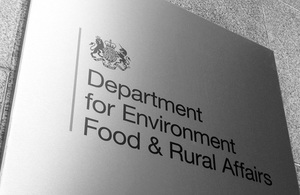Strengthened cattle controls to help eradicate bovine TB
Measures to reduce the risk of bovine TB being spread between cattle are to be strengthened as part of the Government's plan to eradicate the disease in England.

Measures to reduce the risk of bovine TB being spread between cattle are to be strengthened as part of the Government’s plan to eradicate the disease in England.
From 1 July amendments to the rules on cattle movements will come into force, alongside changes to compensation policy, including reduced payments for owners of TB affected herds with overdue tests.
Announcing details of the changes, Agriculture Minister Jim Paice said:
“We need to stop the spread of bovine TB, that last year led to the slaughter of 26,000 cattle and could cost the taxpayer a billion pounds over the next ten years unless action is taken. These strengthened measures, alongside work to pilot badger culling, and the development of badger and cattle vaccines, aim to help control the disease and eventually eradicate it.
“Farmers have shown their commitment to tackle this devastating disease which is taking a terrible toll on their communities and businesses.”
Changes to cattle controls were announced as part of the package of measures to tackle bovine TB in July 2011. The final details of the changes to be introduced on 1 July include:
- Removing the exemption allowing cattle held on a farm for under 30 days to be moved without being tested, in order to reduce the risk of untested cattle spreading bovine TB when they are moved between different holdings;
- Removing the pre-movement testing exemption for movements within ‘Sole Occupancy Authorities’ that have holdings in high and low risk TB areas;
- Pre-movement testing for cattle moved from higher TB risk herds to agricultural shows where cattle are housed or are held there for more than 24 hours - to reduce the risk of untested cattle, from higher TB risk herds, spreading the disease through close contact with other cattle; and
- Discouraging late testing of cattle for bovine TB to reduce disease spread risks for all cattle, by reducing compensation for owners of TB affected herds if tests are overdue by more than 60 days.
To further reduce the risk of TB spreading we will tighten controls around linked premises. Farmers likely to be affected will be contacted, and from 1 July:
-
No new Sole Occupancy Authorities will be approved; and
-
No new Cattle Tracing System links between holdings in high and low TB risk areas will be approved, with existing links between high and low risk areas being removed on a phased basis.
Jim Paice added:
“The farming community has shown it is willing to shoulder its share of the burden to tackle bovine TB. There is already a comprehensive range of robust TB in cattle control measures in place, but we must continuously look for ways to tighten them if we are ever going to get on top of this devastating disease.”
Additional cattle categories are also being introduced to make the TB compensation system more transparent and to remove some anomalies. A new compensation category will be introduced for young pedigree beef animals, and the dairy calved animals category will be split into two age bands.
Notes
For full details of the changes to cattle controls please visit http://www.defra.gov.uk/animal-diseases/a-z/bovine-tb/.
Animal disease control is a devolved matter, and this announcement relates to bovine TB disease control in England only.
Bovine TB is a devastating disease that in 2011 led to the slaughter of 26,000 cattle, and could cost the taxpayer a billion pounds over the next ten years unless action is taken.
An informal consultation on these changes was held in December 2011 for key stakeholders including farming and veterinary organisations, auctioneers, valuers and the TB Eradication Group (TBEG) on the changes. The consultation document and stakeholder response summary will be published on Defra’s website.
Following public consultation, in July 2011 Defra announced the Government’s Bovine TB Eradication Programme for England and in January 2012 confirmed the two areas where applications to carry out pilot badger culling could take place http://www.defra.gov.uk/news/2012/01/19/pilot-areas-confirmed/.
The Government remains committed to research into a cattle vaccine and an oral badger vaccine, with the goal of having these vaccines licensed, available and widely used in the field. We are investing in further research, which will also be used to press the case in Europe for changes to EU legislation to enable cattle vaccination. However, we cannot say with any certainty if and when they will be ready for deployment in the field.
Numbers of TB cases nationally can be found at www.defra.gov.uk/statistics/foodfarm/landuselivestock/cattletb/national with cases broken down by region at www.defra.gov.uk/statistics/foodfarm/landuselivestock/cattletb/regional.
The package of measures already in place to control and eradicate bovine TB includes:
- Routine testing and surveillance of all cattle based on risk. We have already significantly expanded the areas subject to experiencing more frequent testing;
- Pre-movement testing of cattle from high risk areas;
- Movement restrictions on animals from herds that have or are suspected of having bovine TB;
- The slaughter of all cattle that have tested positive for bovine TB;
- DNA tagging of cattle that have proved positive, before they are slaughtered, to prevent fraud;
- Advice and support for farmers that have had cases of bovine TB in their herds on biosecurity and reducing the risk of bovine TB; and
- Research into how bovine TB is spread, and the continuing development of oral badger and cattle vaccines.
In low TB incidence areas the routine TB test interval is set at every three or four years, and in high TB incidence areas the routine TB test interval is set at every one or two years.
Cattle keepers likely to be affected by the changes to SOAs and CTS linked holdings will be contacted and provided with further guidance at the time the change may impact them.